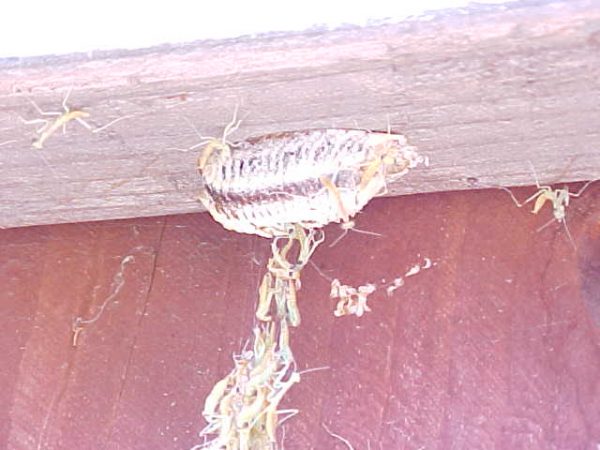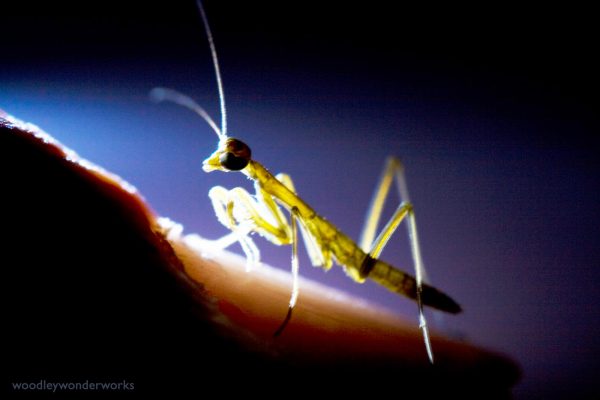When I woke up that morning, they were everywhere. Hundreds of tiny insects were swarming in the dim morning light of my dining room and kitchen. They were climbing the walls, clinging to the ceilings, and edging toward my stained-glass windows. I was too sleepy to scream, but a few rubs of my tired eyes later, I managed to utter a “what in the world?”
I gathered my bathrobe in my hands and crept over to the nearest cluster of the critters that looked quite a bit like crawling lightbulb filaments, just shorter. As I lifted up my glasses (farsighted) to get a better look, I raised my left brow and then furrowed my right. “They are baby praying mantises,” I said out loud to my empty kitchen. Just me and a horde of newly hatched insects peppering my décor with their half-inch bodies lurching toward who knows what.

I did what any college-educated person would do after finding their house filled with bugs: I googled. In minutes I had positively identified them as mantis infants, learned their likelihood of entry, and that all around me as I slept a massive cannibalistic feast had been taking place. It turns out, newly hatched praying mantises eat other newly hatched praying mantises, or rather, mantises, which is proper. I was a little horrified and rather disgusted.
So, I made myself a cup of jasmine tea and took a seat in the mantis-free living room to ponder this crisis.
According to my research, the nest likely came in the house on the live Christmas tree we had chopped down a week or so before. Fraser fir trees are popular locations for female praying mantises to build their nests. Despite the tree farm workers shaking the loose needles off the tree and wrapping it in netting, the nest endured. In fact, that mantis nest, about the size of a Meyer lemon, held its grip for a 20-mile interstate ride at 70 miles an hour. And that is saying something significant because the tree we chose the year before broke in half and fell off the top of our SUV once we hit 65.
I learned from the University of Illinois Extension Office that a typical mantis nest holds 200-400 mantises. I took a big gulp of my tea and with it accepted that I had a problem that I wasn’t sure I could solve.
I read on.
Newly hatched mantises either eat each other or starve to death. Either way, my house was an ongoing site of miniature carnage. Nothing says Happy Holidays quite like the slow and horrifying deaths of hundreds of mantises. I wanted to save them! I scrambled to find solutions: Move them outside? But how? They were likely born immature, and they are fragile. Feed them? But what? How? More research revealed the sad truth: there was nothing I could do after they had already hatched.
If I had found the nest while it was still intact, I could have moved it outside to the nearest pine tree. The entomologists also urge the lucky finders of mantis nests to avoid insecticides to allow your new outdoor friends to thrive, since they eat other insects that are harmful to plants.

But it was too late for this crew. I couldn’t stand the thought of a mercy killing, which is ironic given the mantis’ reputation as a skilled killer of everything from aphids to grasshoppers. I just couldn’t stomach smashing them, so I let them live with me and my family, knowing their chance of survival was zero to none. After all, I figured, some people keep them as pets. How harmful could it be?
Each day as we moved closer to Christmas, there were fewer mantises. I assume that most of them had been eaten because I rarely found any remains. Once in a while, I would find a dried body on the counter or in the dustpan when I swept the floor, but within about three days, they were just about gone. By Christmas Eve, no sign was left that they were ever here, but the shell of their nest, which I had thrown away as soon as I discovered it deep inside the tree.
Their sudden appearance and quick departure were both startling and depressing. No one wants insects roaming freely around their home, but their incredibly short lives (they normally live around a year) seems to come and go in a blink. No sound. No fury. But they signified something: life is too short. As cliché as I know this is, the unexpected mantises reminded me that tomorrow is promised to no one … and to always check live Christmas trees for traveling companions.



